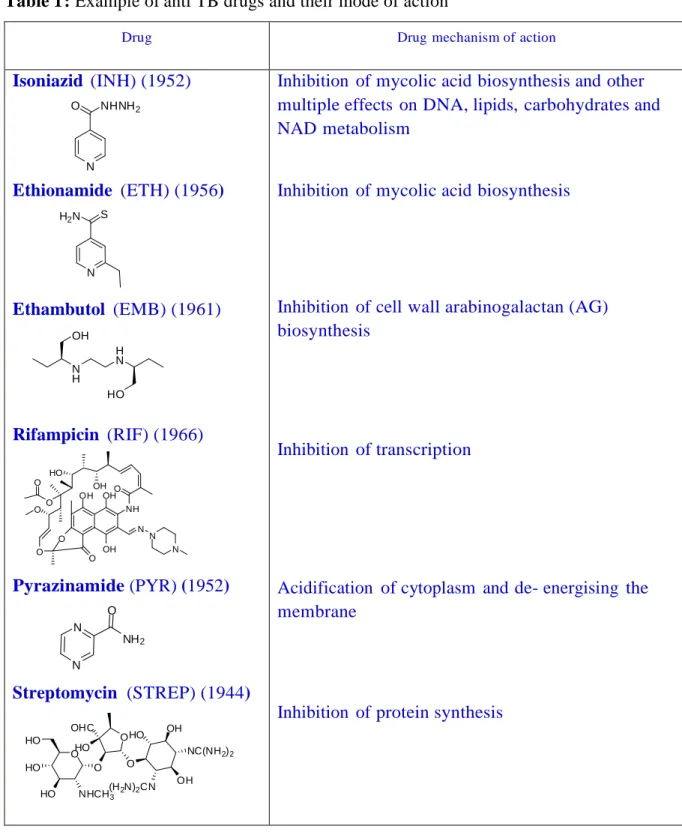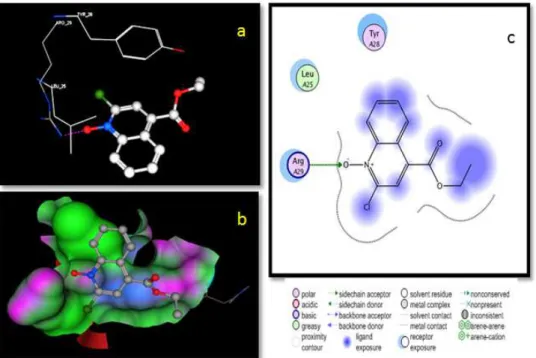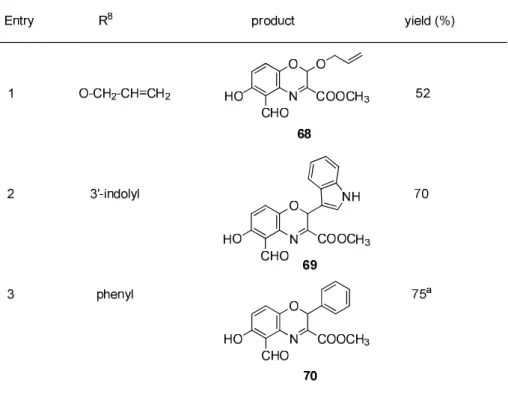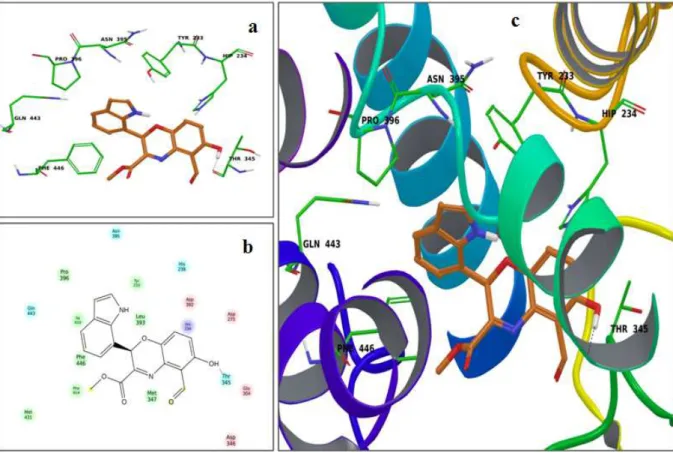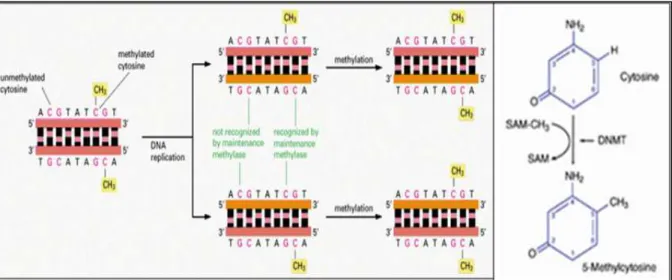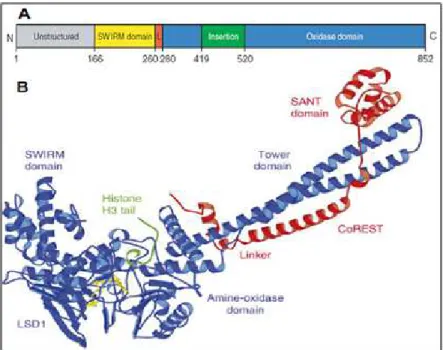Synthesis and Pharmacological N & O Containing Heterocyclic C
Zur Erlangung des Doktorgrades
an der Fakultät für Chemie und Pharmazie der Universität
Synthesis and Pharmacological Characterization
N & O Containing Heterocyclic Compounds as Potential Therapeutic Agents
Dissertation
Zur Erlangung des Doktorgrades (Dr. rer. nat.)
an der Fakultät für Chemie und Pharmazie der Universität Regensburg
vorgelegt von Balakrishna Dulla
aus Rajam (Indien) Regensburg 2013
haracterization of Novel
ompounds as Potential
Die Arbeit wurde angeleitet von: Prof. Dr. Oliver Reiser und Prof. Dr. Javed Iqbal Promotionsgesuch eingereicht am: 20.09.2013
Promotionskolloquium am: 11.10.2013
Prüfungsausschuss: Vorsitz: Prof. Dr. Robert Wolf 1. Gutachter: Prof. Dr. Oliver Reiser 2. Gutachter: Prof. Dr. Javed Iqbal 3. Prüfer: Prof. Dr. Joachim Wegener
Der experimentelle Teil der vorliegenden Arbeit wurde unter der Leitung von Herrn Prof. Dr. Oliver Reiser in der Zeit von July 2009 bis July 2013 am Institut für Organische Chemie der Universität Regensburg und am Institute of Life Sciences, Hyderabad, Indien, angefertigt.
Herrn Prof. Dr. Oliver Reiser möchte und Hern Prof. Dr. Javed Iqbal ich herzlich für die Überlassung des äußerst interessanten Themas, die anregenden Diskussionen und seine stete Unterstützung während der Durchführung dieser Arbeit danken.
Meinen Eltern
“Dream is not what you see in sleep. It is the thing which does
not let you sleep.” Dr. A. P. J. Abdul Kalam
Abstract
B. Dulla, PhD thesis (2013)
Abstract:
The majority of pharmaceuticals and biologically active agrochemicals are heterocyclic compounds; it represents their immense importance in serving mankind. The purpose of this thesis was to investigate feasibility of making potential biological active noval heterocyclic compounds designed based on lead molecules. The work accomplished in this thesis includes five different chapters to explain importance, achieve simple and fused-ring heteropolicyclic systems having potential pharmacological properties.
The first chapter briefly explains importance of heterocyclic compounds and research objective.
The second chapter of thesis concerns with target-oriented synthesis to access complex dehydro shikimate analogues containing a pyridine/isoquinoline unit with antitubercular activities with MIC: 4-10µM. Third chapter deals with study of novel synthetic approach to the one pot synthesis of 2H-benzo[b] [1,4]oxazines with anti inflammatory activites.
In the fourth chapter is presented as a series of functionalized phenyl oxazole derivatives were designed, synthesized and screened in vitro for their activities against LSD1 and for effects on viability of cervical and breast cancer cells (IC50: 1-10 nM), and in vivo for effects using zebrafish embryos. Indeed it also explains the designing and cost effective route to synthesis of LSD1 inhibitors. Finally, fifth one is related to the intramolecular 1,3-dipolar cycloaddition of isovanillin derived N-aryl hydroxylamines possessing ortho-allylic dipolarophiles affords novel benzo analogues of tricyclic isoxazolidines that can be readily transformed into functionalized lactams, γ-aminoalcohols and oxazepines. The corresponding N-unsubstituted hydroxylamines give rise to tetrahydroisoquinolines. Anxiogenic properties of these compounds were tested in zebrafish.
Moreover, in all chapters in silico docking studies were performed to predict binding interactions of the most potent scaffolds synthesized and reported inhibitors with the selected targets. At the end of each chapter are drawn a series of conclusions, concerning the investigations performed and the results obtained. Prof. Dr. Oliver Reiser (advisor), Prof. Dr.
Javed Iqbal (advisor), Prof. Joachim Wegener, Prof. Dr. Robert Wolf (Committee Members).
Table of Contents
Table of contents
1. General introduction
1.1 Pharmacological significance of Heterocycle scaffolds 1.2 Research envision
1.3 References
1 3 4
2. Design, synthesis & pharmacological evalution of dehydroshikimate analogues as potential antitubercular agents
2.1 Introduction
2.1.1 Definition of Tuberculosis 2.1.2 Pathogenesis of Tuberculosis
2.1.3 Overview of TB infection and hot defence 2.1.4 Epidemiology of Tuberculosis
2.1.5 Mechanism of action
2.1.6 Classification of antitubercular drugs 2.1.7 TB Drug Resistances
2.2 Shikimate pathway
2.3 Design of new and potential antitubercular agents from known DHS analogues.
2.4 Results and discussion 2.4.1 Chemistry 2.4.2 Pharmacology
2.4.3 Molecular docking studies 2.5 Summary
2.6 Experimental section
2.6.1 Chemistry general methods 2.6.2 Synthesis
2.6.3 Single crystal X-ray data for compound 3e, 5a and 5b 2.6.4 Pharmacology methods
2.6.5 Docking procedure 2.7 References
5 5 5 5 6 7 8 8 9 10 13 13 18 19 22 22 23 24 36 37 39 41
Table of Contents
3. Novel synthesis of 2H-benzo[b][1,4]oxazines via sequential C-N and C-O bond formation in single pot and their pharmacological evaluation as anti
inflammatory agents 3.1 Introduction
3.2 Literature reports for synthesis of 1,4-benzoxazines 3.3 Dearomatisation of arenes
3.4 Results and discussion
3.4.1 Our approach for synthesis of 2H-benzo[b][1,4]oxazines via one pot sequential C-N, C-O bond formation
3.4.2 The single crystal X-ray study of compound 69 3.4.3 Pharmacology
3.4.2 Molecular docking studies 3.5 Summary
3.6 Experimental section
3.6.1 Chemistry general methods 3.6.2 Synthesis
3.6.3 Single crystal X-ray data for compound 69 3.6.4 Pharmacology methods
3.6.5 Docking procedure 3.7 References
42 43 47 50
50 55 56 57 60 60 60 61 68 68 70 71
4. Synthesis & pharmacological evolution of substituted phenyl oxazoles as a novel class of LSD1 inhibitors with anti-proliferative properties
4.1 Introduction 4.2 Epigenetics
4.2.1 Epigenetic alterations in the genesis of cancer 4.2.2 Lysine-specific histone demethylase 1 (LSD1) 4.3 Design of novel LSD1 inhibitors
4.4 Results and discussion 4.4.1 Chemistry 4.4.2 Pharmacology
4.4.2.1 Cell viability
74 74 74 76 78 80 80 82 82
Table of Contents
4.4.2.2 In vitro LSD1 activity
4.4.2.3 Zebra fish embryo toxicity and apoptosis 4.4.3 Molecular docking studies
4.5 Summary
4.6 Experimental section
4.6.1 Chemistry general methods 4.6.2 Synthesis
4.6.3 Pharmacology methods
4.6.3.1 Evaluation of cell viability
4.6.3.2 Evaluation of in vitro LSD1 activity
4.6.3.3 Evaluation of in vivo apoptosis and toxicity using zebra fish embryos
4.6.4 Molecular Modelling studies 4.6.4.1 Docking method
4.6.4.2 Molecular Dynamics Simulations Protocols 4.7 References
84 84 87 92 92 92 93 106 106 106
107 108 108 108 110
5. Design, synthesis & pharmacological evolution of isovanillin derived isoxazolidines as potential vanilloid receptors
5.1 Introduction
5.1.1 Importance for Noval Scaffolds to Treat Pain
5.1.2 The Transient Receptor Potential (TRP) Super family 5.1.2.1 Physiological functions of TRPV1
5.1.2.2 TRPV1 Agonists 5.1.2.3 TRPV1 Antagonists 5.2 Research objective
5.3 Results and discussion 5.3.1 Chemistry 5.3.2 Pharmacology
5.3.2.1 Video for anxiogenic acitivity of compound 23 5.3.3 Molecular docking
113 113 114 116 116 117 118 120 120 125 126 126
Table of Contents
5.4 Summary
5.5 Experimental section
5.5.1 Chemistry general methods 5.5.2 Synthesis
5.5.3 Single crystal X-ray data for compound 16a 5.5.4 Pharmacology methods
5.5.5 Molecular docking studies
5.5.5.1 Homology modelling of catalytic site of rat TRPV1 receptor 5.5.5.2 Docking procedure
5.6 References
127 130 131 132 132 149 149 150 152 154
6. Appendix
6.1 NMR Spectra 6.2 Curriculam Vitae
156 253
7. Acknowledgements 258
8. Declaration 260
Abbreviations
List of Abbreviations
Abs absolute
AIDS acquired immunodeficiency syndrome
aq aqueous
Bn benzyl
Bz benzoyl
Bu butyl
CCDC cambridge crystallographic data centre
calcd calculated
cat catalytic
CI chemical ionization (MS)
d day(s)
DCM dichloromethane
DMAP 4-dimethylaminopyridine DMF dimethylformamide DMSO dimethyl sulfoxide dr diastereomeric ratio
EI electron impact (MS)
ent enantiomer
equiv equivalent(s)
ESI electrospray ionization (MS)
Et ethyl
EtOAc ethyl acetate
GC gas chromatography
h hour(s)
HPLC high-pressure liquid chromatogaphy HRMS high resolution mass spectrometry
Hz hertz
HIV human immunodeficiency virus
i iso
IR infra red spectroscopy LAH lithium aluminium hydride LSD1 lysine specific demethylase1
LORA low oxygen recovery assay
M molar / metal
Me methyl
µM micro molar
min minute(s)
mp melting point
MS mass spectroscopy
Mtb mycobacterium tuberculosis NMR nuclear magnetic resonance
nd not determined
no number
NOE nuclear Overhauser effect
Nu nucleophile
ORTEP oak ridge thermal ellipsoid plot
PDE4B cAMP-specific 3',5'-cyclic phosphodiesterase 4B
PE hexanes
ppm parts per million Ph phenyl
PDB protein data bank quant quantitative
rac racemic
rt room temperature
t tert
SDH shikimate dehydrogenase TBAF tetra-n-butylammonium fluoride
TBS tert-butyldimethylsilyl TBSCl tert-butyldimethylsilyl chloride
TFA trifluoroacetic acid
THF tetrahydrofuran
TLC thin layer chromatography TNF-α tumor necrosis factor alpha
Ts tosyl
wt weight
01234 56 8
!"!#$% & '"( #)*+,( - )"&
./.&01$#2$,)%)3-,$%&4-3"-5-,$",!&)5&6!(!#),7,%!&4,$55)%*8&
9999999999:9;<=<>?@A@BC@9@?DE?FGH9CI9J9@A@BC@9@?DE?FGH9=;J=9;JI9J=?DI9?K9J=9B<JI=9=L?9HCKK<><G=9
<B<D<G=I9JI9D<DM<>I9?K9C=I9>CGNOIPQ9R<=<>?@A@BC@9@;<DCI=>A9CI9=;<9M>JG@;9?K9@;<DCI=>A9H<JBCGN9 LC=;9IAG=;<ICIS9E>?E<>=C<IS9JGH9JEEBC@J=C?GI9?K9;<=<>?@A@B<IQ9T;<9UVW:X9><@?DD<GHI9=;<9 RJG=YI@;Z[CHDJG9G?D<G@BJ=F><9K?>9GJDCGN9;<=<>?@A@BC@9@?DE?FGHIQ\9R<=<>?@A@B<I9K?>D9MA9 KJ>9=;<9BJ>N<I=9?K9=;<9@BJIIC@JB9HC]CIC?GI9?K9?>NJGC@9@;<DCI=>A9JGH9=;<9DJ^?>C=A9?K9 E;J>DJ@<F=C@JBI9JGH9MC?B?NC@JBBA9J@=C]<9JN>?@;<DC@JBI9J><9;<=<>?@A@BC@S9JI9J><9@?FG=B<II9 JHHC=C]<I9JGH9D?HCKC<>I9FI<H9CG9CGHFI=>C<I9JI9]J>C<H9JI9@?ID<=C@IS9><E>?N>JE;AS9CGK?>DJ=C?G9 I=?>JN<S9JGH9EBJI=C@I9CGH<<H9=?9FGH<>I=JGHCGN9?K9BCK<9E>?@<II9JGH9=?9=;<9<KK?>=I9=?9CDE>?]<9=;<9 _FJBC=A9?K9BCK<Q`99
aJGA9GJ=F>JB9H>FNI9bcZdef9IF@;9JI9J=>?ECG<9O.PS9@?H<CG<9OgPS9<D<=CG<9OhPS9D?>E;CG<9OiPS9 EJEJ]<>CG<9OjPS9E>?@JCG<9OkPS9_FCGCG<9OlPS9=;<?M>?DCG<9OmPS9JGH9=;<?E;ABBCG<9OnP9J><9
;<=<>?@A@B<IQ9a?I=9?K9=;<9IAG=;<=C@9H>FNI9IF@;9JI9JG=CEA>CG<9O.oPS9JYCH?=;ADCHCG<9O..PS9 MJ>MC=F>J=<I9O.gPS9@;B?>E>?DJYCG<9O.hPS9CI?GCJYCH9O.iPS9HCJY<EJD9O.jPS9JGH9D<=>?GCHJY?B<9O.kP9 J><9JBI?9;<=<>?@A@B<I9OpCNF><9\PQ9qCG@<9JBD?I=9JBB9MC?B?NC@JB9E>?@<II9J><9@;<DC@JB9CG9GJ=F><9 JGH9JI9;<=<>?@A@B<I9J><9JMB<9=?9N<=9CG]?B]<H9CG9JG9<r=>J?>HCGJ>CBA9LCH<9>JGN<9?K9><J@=C?GI9
=;<I<9GJ=F>JB9JGH9IAG=;<=C@9;<=<>?@A@BC@9@?DE?FGHI9@JG9JGH9H?9EJ>=C@CEJ=<9CG9@;<DC@JB9
><J@=C?GI9CG9;FDJG9M?HAQ9
qAG=;<=C@9;<=<>?@A@B<I9;J]<9LCH<9IE><JH9=;<>JE<F=C@9FI<I9IF@;9JI9JG=CMJ@=<>CJBS9JG=CKFGNJBS9 JG=CDA@?MJ@=<>CJBS9=>AEJG?@CHJBS9JG=CZRUs9J@=C]C=AS9JG=CB<CI;DJGCJB9JN<G=IS9N<G?=?rC@S9 JG=C=FM<>@FBJ>S9JG=CDJBJ>CJBS9;<>MC@CHJBS9JGJBN<IC@S9JG=CZCGKBJDDJ=?>AS9DFI@B<9><BJrJG=IS9 JG=C@?G]FBIJG=S9JG=C@JG@<>9JGH9BCECH9E<>?rCHJ=C?G9CG;CMC=?>S9;AEG?=C@IS9JG=CH<E><IIJG=S9 JG=C=FD?>S9JG=;<BDCG=C@9JGH9CGI<@=C@CHJB9JN<G=IQt999999999
u u
uv w
x
u vyzu
v v vu
w
{
w
vw
vyzu uzvy
uzvy uzvy v
vv
|
u vu
v v
vu
w
}
01234 56 8
!"#$
!"#$
%
!&
$
$
'
!"#$
$!
(
!
$
$ )
$
$
*
$ +,
!
$
$ $
!$
" ++
!
$ !
$
$
+-
.
#/
+0
$ ! !&
+1 #/
$
+%
!"#$
!"#$
!$
$&
+'
23456789:;<=>;?@ABC@DE;FG?AH=AIJ;KCBLF;JM?FIFAI?L;MN;H=A=CMJGJDIJ;CI?LF;
OCMPQA=K;RG;AH=F=;MRF=CS@AIM?F;IA;IF;JD=@C;AH@A;H=A=CMJGJD=F;QD@GI?L;@;SIA@D;CMD=;I?;F=CSI?L;
P@?TI?KU;VBA;?M>@K@GF;KB=;AM;I?JC=@FI?L;JMFAF;MN;C=F=@CJHE;K=S=DMQP=?A;@?K;@;FIPBDA@?=MBF;
FA@L?@AI?L;?BPR=C;MN;?=>;JH=PIJ@D;=?AIAI=F;WXYZF[;AH=;=?AIC=;QH@CP@J=BAIJ@D;I?KBFACG;IF;
N@JI?L;>IAH;AH=;JH@DD=?L=;MN;I?JC=@FI?L;QCMKBJAISIAG;@?K;I??MS@AIM?U;\H=;J@BF=;MN;AHIF;
I??MS@AIM?;K=NIJIA;IF;K=NI?IAIS=DG;?MA;AH=;RIMDMLGE;R=J@BF=;DIA=C@ABC=;QC=J=K=?AF;FHM>I?L;AH@A; ]E^^^;L=?=F;@C=;FIL?INIJ@?ADG;I?SMDS=K;I?;AH=;=P=CL=?J=;@?K;JMBCF=;MN;KIF=@F=;MBA;MN;_^^^^;
HBP@?;L=?=FU;<BCAH=CPMC=E;R=J@BF=;=@JH;MN;AH=F=;L=?=F;IF;DI?T=K;AM;AH=;NB?JAIM?;MN;R=A>==?;
NIS=;@?K;A=?;QCMA=I?FE;AH=;JM?JDBFIM?;IF;AH@A;AH=C=;PILHA;R=;`E^^^;a;]^E^^^;A@CL=AF;NMC;?=>;
KCBLFU;_;b=?J=E;AH=;PMFA;JH@DD=?LI?L;AHI?L;IF;?MA;M?DG;AM;F=D=JA;KCBL@RD=;A@CL=AFE;RBA;@DFM;NI?K;
JMCC=FQM?KI?L;KCBLcDIT=;J@?KIK@A=FE;FBRFA@?J=F;>IAH;FQ=JINIJ;QH@CP@JMTI?=AIJ;@?K;
AMdIJMDMLIJ@D;QCMQ=CAI=FE;AH@A;@DDM>;AH=P;AM;R=;K=S=DMQ=K;@F;@;KCBLU;
ZS=?;AHMBLH;P=KIJI?@D;JH=PIFACG;@F;@;FJI=?AINIJ;KIFJIQDI?=;H@F;I?ACMKBJ=K;F=S=C@D;?=>;
A=JH?IeB=F;AM;FQ==K;BQ;AH=;KCBL;KIFJMS=CG;QCMJ=FFE;FBJH;@F;JMPRI?@AMCI@D;JH=PIFACGE; PIJCM>@S=c@FFIFA=K;MCL@?IJ;FG?AH=FIFE;@?K;HILHcAHCMBLHQBA;QBCINIJ@AIM?;AH=;?BPR=C;MN;XYZF;
C=@JHI?L;AH=;P@CT=A;H@F;@JAB@DDG;K=JC=@F=K;KC@P@AIJ@DDGUf;\HIF;IF;QCMR@RDG;KB=;AM;IPQCMQ=C; F=D=JAIM?;MN;KCBL;DIT=;PMD=JBD=FU;;
gA;H@F;R==?;=FAIP@A=K;AH@A;AH=;?BPR=C;MN;QMFFIRD=;PMD=JBD=F;>IAH;@;PMD=JBD@C;>=ILHA;MN;D=FF;
AH@?;`^^;h@;WiIQI?FTI;CBD=[;IF;]^j^^E;MN;>HIJH;M?DG;]^k^;P@G;QMFF=FF;KCBLcDIT=;QCMQ=CAI=FU;\H=;
IFFB=;IF;AH=C=NMC=;AH=;F=D=JAIM?;MN;?=>;PMD=JBD=F;NCMP;AHIF;S@FA;B?IS=CF=;AH@A;H@S=;AH=;
QMA=?AI@D;AM;R=;RIMDMLIJ@DDG;@JAIS=U`;;\H=;QMFFIRD=;MQAIM?F;AM;NI?K;RIMDMLIJ@DDG;@JAIS=;PMD=JBD=F;
01234 56 8
!"#$%&'()%*+,!'!+-)./%+")%01-+',',$%2'-.%3%4'"-#+&%.*")),',$%+55"0+*2%+,!%2'$26-2"0#$25#-% .*")),',$/%0"%*+,%1)%*05')!%7"08%.*'),-'7'*%0"%5+-),-%&'-)"+-#")9%:.%-2)%8+',%',-)").-%07%-2)%
;+10"+-0"<%07%=)!'*',+&%>2)8'.-"<%&+<.%',%-2)%.<,-2).'.%+,!%1'0&0$'*+&%)4+&#+-'0,%07%,04)&% 2)-)"0*<*&).?%@)%2+4)%*20.),%-2)%&+-)"%+55"0+*2%07%.)&)*-',$%&)+!%80&)*#&).%07%5+"-'*#&+"% -+"$)-%70"%!'77)"),-%!'.)+.).%7"08%.*'),-'7'*%0"%5+-),-%&'-)"+-#")%+,!%8+(',$%+,+&0$#).%07%-2+-%
&)+!%80&)*#&)%@'-20#-%*2+,$',$%52+"8+*0520")%").50,.'1&)%70"%',-)"+*-'0,%@'-2%-2)%.5)*'7'*%
-+"$)-%-0%'85"04)%50-),*<?%.)&)*-'4'-<%0"%52+"8+*0(',)-'*%5+"+8)-)".9%%
A,%0"!)"%-0%'85"04)%-2)%2'-%"+-)%',%2'$26-2"0#$25#-%.*")),',$%*+85+'$,.?%5"'4'&)$)!%.-"#*-#").%
5"04'!)%+,%'!)+&%.0#"*)%07%&)+!%*0850#,!.9%:%.',$&)%&'1"+"<%1+.)!%#50,%5"'4'&)$)!%
.#1.-"#*-#").B%*+,%&)+!%-0%+*-'4)%*0850#,!.%',%4+"')-<%07%1'0&0$'*+&%+..+<.9%C)4)"+&%").)+"*2%
$"0#5.%2+4)%#-'&'D)!%-2).)%.-"#*-#").%',%.#*2%+%8+,,)"9%E0"%)F+85&)?%G'*0&+#%+,!%*06@0"()".%
*0,.-"#*-)!%+%&'1"+"<%1+.)!%0,%-2)%1),D05<"+,%HI/%5"'4'&)$)!%.*+770&!?J%@2)")+.%C*2#&-D%+,!%
*06@0"()".%8+!)%#.)%07%-2)%5#"',)%HK/%.*+770&!L%E'$#")%M/9%
N
O
O O P O
QR QS
TUVWXYZ[\%]2)%1),D05<"+,%+,!%5#"',)%5"'4'&)$)!%.*+770&!%
%
H^[Z_Y`YaXbcZdefYbgUhY%
i#"%',-)").-%1)2',!%-2)%!).'$,%07%,04)&%2)-)"0*<*&'*%*0850#,!.%1+.)!%0,%&)+!%*0850#,!.?% .<,-2).'.%+,!%1'0&0$'*+&%)4+&#+-'0,%'.%-2+-%+&&%07%-2).)%*0850#,!.%+")%,0-%7")j#),-&<%#.)!%k6 2<!"0F<6M60F06k?M6!'2<!"05<"'!',)6l6*+"10F<&'*+*'!.% Hma/?%k62<!"0F<6M60F06k?M6!'2<!"0%
j#',0&',)6l6*+"10F<&'*%+*'!.% Hme/?%J6*2&0"06M?l6!'0F06k?M?n?l?l+?L+62)F+2<!"05<"'!0%oM?n6
!p5<"'8'!',)6q6*+"10F<&'*+*'! Hmb/?% k6n6l68)-2<&6q6M68)-2<&% -2'0/)-2<&/0F+D0&6M6<&/% 52),<&/% $#+,'!',)% [r/?% J62<!"0F<6L68)-20F<6k652),<&6q?q+?B?ks16-)-"+2<!"06kt6 ',!),0ok?M6)pok?lp0F+D)5',6M nt/60,)% [H/%+,!%Mt6u),D0ovpok?lp0F+D',).% [[/%+,!%+")%
-0-+&&<%+1.),-%',%*088)"*'+&%*0850#,!%&'1"+"').?%+,!%2+4',$%.'8'&+"%52+"8+*0&0$'*+&% 7)+-#").%+.%&)+!%*0850#,!.?%5"085-)!%#.%-0%)&+10"+-)%-2'.%-<5)%07%%8)!'*',+&%*2)8'.-"<%
+55"0+*2%+,!%-0%.<,-2).'D)%!'77)"),-%,04)&%2)-)"0*<*&'*%.*+770&!.%2+4',$%50-),-'+&%1'0&0$'*+&% +*-'4'-').%E'$#")%n/9%
01234 56 8
!"
!
#
$
%
&
' !"
"(!
&)
%) !"
"(! !"
*+"
"*+
!
#
#
#"
# (,
"
"
- ./0
/
12
13 4
&)567#'8
%)#"7#'87!"!"( 9)#"7#:
,;
')<=>?@67A:B+5C"D7A:E5C"D7A:5"85C"D7
A:5"8F5"5"8G5C"D7A#5"85C"D7A:#5#H=5C"D7
#5"(H=5C"D7#:I66@678J:K?L*6@67,:?I<=M=@6
!
# '
5"#
"# 5##';
((
$N"O?=KPKM*+QFR?MKMSP>+TS6I+QTIUU*6LQG V$N,O?=KPKM*+QFR?MK:5I?T>+QTIUU*6LQG
W'HX,'>T><M*+QFHIK?+>6K>YK?ZQTIUU*6LQG HN[DBO?=KPKM*+QFR?MK:K?U6I\\IM*+@QTIUU*6LQG (]
^_`abcdefghijiklmnoipqrsktustkirqvwqrxjsyirnoipqjvzimqyisikvuxumnuqrulwwvmpr{q|n}ymn}ysipq lkilrqvwqsyiql~vziqjvzimqrulwwvmprqikiqslijqwkvqmilpqvmiutmir{q
ccbc cfd
{ljnuvq{qvimmq{q|{qnuyikq{q{qmluimmqunijui{eqqq
{qqqqq
{q tlq{qyknzlrslzlq{qvjljiq{q¡{qknzlrslzl{q{q¡{qq¢£¤¥¦¥§§¦
¨©¦{qª«q¬q{q
{lq kirq{q®¦¥¦qª«««q¯°q±{q~qirrqh{qkljjq²{qnuij~ik}ikq{q
¢¥³´µ¶¥·£qª««qq{q
{¸v~lkpnjvq{qh{q¸viq{q{q¹¨¤©¦§¤{qª««ºqq»{q
»{¡vm~q|{q{q¼njjq²{qh{qylk½mirrq¡{q{qq¢¥³´µ¶¥·£ª««qq{q
{¾zljrq{q¾{qnssmiq¡{q¾{qvuq²{qh{q n½lkpvq{q²{q¼kinpnj}ikq{q²{qynssikq
{q¸{q¸tjpimmqh{q¼{q¿i~ikq {q¼{qjpikrvjq{q{qylj}q{{q¸{q¸vssnq¿{q{q
iknjvq {q{qyijqÀ{q{q¡mnj}q{q{q¡tjimq¡{q{q½knj}ikq{q{q|nkrywnimpq{qqqq Á£´µqÃÃqq»{q
Ä{nuvmlvtq¡{q{qwiwwikvkjq{q{qviuikq{q{qlvqh{qÅ{qlkmtij}lq{q
²nsuyimmq|{q{qÁ¢µ´µ®§¦qª«««qq±±±{q
{ nj}q{qhklxq{q{q nj}qÅ{quytmsoq{qh{qÆ©£©§¥Ç{qª««qqÄ»{
Chapter 2
B.Dulla, PhD Thesis (2013) Page 5
2. Design, synthesis & pharmacological evolution of dehydro shikimate analogues as potential antitubercular agents
1 Introduction:
1.1 Definition:
Tuberculosis is an infectious disease characterized by the growth of nodules (tubercles) in the tissues, especially in the lungs. Bacillus Mycobacterium tuberculosis is the etiological agent of TB belonging to the genus Mycobacterium, which is presumed to have originated more than 150 million years ago. Tuberculosis (TB) is one of the leading causes of death due to a single infectious organism in the world. It typically affects the lungs (pulmonary TB) but can affect other sites as well (extrapulmonary TB).1 The probability of developing TB is much higher among people infected with the Human Immunodeficiency Virus (HIV).
1.2 Pathogenesis of tuberculosis
The primary mode of transmission of M. tuberculosis (Mtb) is through the air in an aerosolized form, most commonly when pulmonary TB bacteria are expelled via a cough or sneeze from people who are sick with TB.2 The infective droplet nuclei trapped in nasopharynx and the upper respiratory tract enters the alveoli, whereby they are ingested by the alveolar macrophages through the process of phagocytosis. In this early stage of the infection, Mtb is able to replicate within non-activated macrophages.3 However the body subsequently mounts a cell-mediated immune response to the growing mycobacterium via the activation of macrophages with interferon-γ which controls Mtb infection, but not wiped out the bacteria from the host.3, 4 In fact, the remaining mycobacterium will enter into the non-replicating persistence phase (latent stage of the infection). Mtb can reside in alveolar macrophages, avoiding the host immune response for an indefinite period of time.
Such latent mycobacterium can get activated anytime later, especially when the host has immune deficiency.
1.3 Overview of TB infection and host defence:
There are three potential outcomes of infection of the human host in M. tuberculosis.
a) The frequency of spontaneous healing is unknown, but is assumed to be rare.
b) Disease progression immediately after infection in the immunocompromised host.
Chapter 2
B.Dulla, PhD Thesis (2013) Page 6
c) In the majority of cases, mycobacteria are initially contained and the disease progresses later due to reactivation.
Figure 1: Overview of TB infection and host defence.
The granuloma is the major site of infection, which develops from infected macrophages a n d becomes surrounded by lymphocytes. Effector T cells (CD4+
CD8+
T cells, and double-negative or CD4/CD8 single- positive T cells that recognize antigen presented by CD1) and macrophages participate in the control of TB.
Crucial macrophage activators interferon-γ (IFN-γ) and tumor-necrosis factor-α (TNF-α) are produced by T cell and macrophages respectively. Macrophage activation permits phagosomal maturation and the production of antimicrobial molecules such as reactive nitrogen intermediates (RNI) and reactive oxygen intermediates (ROI). E x t r a c t e d f r o m N a t u r e R e v i e w s I m m u n o l o g y 1 , 2 0 - 3 0 ( O c t o b e r 2 0 0 1 ) w i t h l i c e n c e .
1.4 Epidemiology of tuberculosis
The burden of disease caused by TB can be measured in terms of incidence, prevalence, and mortality. Globally, the absolute number of incident TB cases per year has been falling since 2006, if these trends are sustained; the MDG (Millennium Development Goals) target that TB incidence should be falling by 2015 will be achieved.
Chapter 2
B.Dulla, PhD Thesis (2013) Page 7
1.5 Structure and Mechanism of action of anti tubercular drugs
The available chemotherapies for M. tuberculosis are mainly relies on drugs which inhibit bacterial metabolism with a special significance on inhibitors of the cell wall synthesis.
Table 1:Example ofanti TB drugs and their mode of action
Drug Drug mechanism of action
Isoniazid (INH) (1952)
Ethionamide (ETH) (1956)
Ethambutol (EMB) (1961)
Rifampicin (RIF) (1966)
Pyrazinamide (PYR) (1952)
Streptomycin (STREP) (1944)
Inhibition of mycolic acid biosynthesis and other multiple effects on DNA, lipids, carbohydrates and NAD metabolism
Inhibition of mycolic acid biosynthesis
Inhibition of cell wall arabinogalactan (AG) biosynthesis
Inhibition of transcription
Acidification of cytoplasm and de- energising the membrane
Inhibition of protein synthesis
The currently available first and second line TB drugs can be grouped as cell wall
N O NHNH2
H2N
N S
OH NH
HN
HO
OH
OH N NH
N O HO
O O
OH OH OO
O
N O
N
N O
NH2
(H2N)2CN
NC(NH2)2
OH HO OH O
O HO
O OHC O
NHCH3
HO HO HO
Chapter 2
B.Dulla, PhD Thesis (2013) Page 8
inhibitors (isonizid (INH), ethambutol, ethionamide), nucleic acid synthesis inhibitors (rifampicin (RIF), quinolones), protein synthesis inhibitors (streptomycin, kanamycin) and inhibitors of membrane energy metabolism (pyrazinamide).
1.6 Classification of antitubercular drugs:
Tuberculosis treatment includes three basic concepts which are as follows: (1) Regimens must contain multiple drugs to which the organism is susceptible. (2) Drugs must be taken regularly. (3) Drug therapy must continue for a sufficient time. Traditionally, antituberculosis drugs are classified as first line drugs are superior in efficacy and posses an acceptable degree of toxicity. If the M. tuberculosis organisms are resistant to the first line drugs, second-line drugs will be preferred which are more toxic and less effective and they are indicated only agents.
Table 2:Examples of 1st line and 2nd line drugs with characteristics
Characteristics Drugs
First line drugs
(Essential anti TB drugs)
High anti TB effect, acceptable degree of toxicity, used routinely
Isoniazid, Ethambutol, Rifampicin, Pyrazinamide, Streptomycin
Second line drugs
(Reserved anti TB drugs)
Low anti TBeffect, high degree of toxicity, used in special circumstances
PAS, Amikacin,
Capreomycin, Ethionamide, Kanamycin, Cycloserine
The common side effects to these antituberculosis drugs include hepatitis, cutaneous reactions, gastrointestinal intolerance, haematological reactions and renal failure which must be adverse effects must be recognised early, to reduce associated morbidity and mortality.
1.3 TB Drug resistance
This disease is complicated by the human immunodeficiency virus (HIV), TB turns out to be most opportunistic co-infection which is growing at an alarming rate with the increase of world human population.5,6 The disease poses a major threat to the human life with the recent emergence of multidrug-resistant (MDR) and extensively drug resistant (XDR)-TB. Because of its increasing prevalence MDR-TB is now subdivided into ‘basic’ MDR-TB, with
Chapter 2
B.Dulla, PhD Thesis (2013) Page 9
resistance only to rifampicin and isoniazid, and ‘MDR-TB-plus’, with a similar resistance pattern but with resistance to one or more additional first- and/or second-line drugs. The most effective drug regimen is endorsed by the WHO and is called Directly Observed Treatment, Short-course (DOTS), developed to fully supervise those patients deemed high- risk for non-drug adherence.7 Since this disease poses a major threat to the human life it requires an immediate attention for the identification and development of novel antitubercular drugs.8
2. Shikimate pathway:
The shikimate pathway plays a pivotal role in the biosynthesis of precursors for aromatic amino acids, vitamins, quinones, and a variety of other aromatic compounds in bacteria, plants, fungi, and apicomplexa parasites.9 The end product of the shikimate pathway is chorismate, which is converted to precursors of a host of secondary metabolities essential for the survival of these organisms. (Figure 2) Shikimate is the first intermediate identified, isolated from fruit of Illicium religiosum (commonly known as the Japanese star anise, shikimi) which gave the name to this pathway.10
Figure 2: Shikimate pathway 2 (self drawn)
1st step: The shikimate pathway begins with the aldol condensation of two phosphorylated 'household metabolites', phospho enolpyruvate (PEP) and D-erythrose 4- phosphate (E4P) catalyzed by 3-deoxy-D-arabino-heptulosonate-7-phosphate (DAHP) synthase. Based on sequence similarity, DAHP synthases are classified into two types. Type
O O
OH
OH SynthaseDAHP E4P
H2O P1
O
HO COOH
OH OH
O DHQS
P1
DHQS
CH2 O COOH
PEP DAHP
HO COOH
OH OH O
3-Dehydroquinate
NADPHNADP+ DHD-SDH
H2O
COOH
OH OH O
3-Dehydroshikimate
COOH
OH OH HO
Shikimate
SK A
T P ADP
COOH
OH OH O
Shikimate 3- phosphate P
P
P
DH EPSPQS syntha se
PEP P1
COOH
O OH O
EPSP CH2
COOH P
P P1
CS COOH
O OH
Chorismate CH2
COOH Amino acids
Vitamins
Chapter 2
B.Dulla, PhD Thesis (2013) Page 10
II DAHP synthases are found in plants and some microbes (e.g., Mycobacterium tuberculosis).
2nd step: 3-Deoxy-D-arabino-heptulosonate-7-phosphate undergoes five consecutive chemical reactions: alcohol oxidation, β-elimination of inorganic phosphate, carbonyl reduction, ring opening, and intramolecular aldol condensation performed by 3-dehydro quinate synthase (DHQS) in one active site using a divalent cation (e.g., Co2+) and NAD+ cofactors to form 3-dehydro quinate.
3rd step: The third enzymatic reaction include the dehydration of 3-dehydroquinate to 3- dehydroshikimate to introduce the first double bond by 3-dehydro dehydratase (DHD).
4th step: Shikimate dehydrogenase plays an important role in catalyzing the fourth step in the shikimate pathway involving the reversible conversion of 3-dehydro shikimate (DHS) and NADPH to yield shikimate, a 3,4,5-trihydroxycyclohexene-1-carboxylic acid and NADP+.
5th step: Shikimate kinase (SK) phosphorylates the C3 hydroxyl group of Shikimate using ATP as a co substrate to yield shikimate 3-phosphate.
6th step: 5-Enolpyruvylshikimate-3-phosphate synthase (EPSP) catalyzes the penultimate step of the shikimate pathway, the addition of enolpyruvyl moiety of phospho enolpyruvate (PEP) to the 5-hydroxyl group of shikimate-3-phosphate.
7th step: The last step of the synthesis of aromatic amino acids, vitamins and quinones catalyzed by chorismate synthase (CS) involves a 1,4-trans elimination of phosphoric acid from 5-enolpyruvylshikimate 3-phosphate introducing the second double bond in the ring to produce chorismate.11
Importantly the shikimate pathway has been shown to be essential for the viability of Mycobacterium tuberculosis.12 The absence of the shikimate pathway in humans and its indispensible importance in algae, higher plants, bacteria, and fungi makes it a potential target for the development of novel antitubercular agents.13
3. Design of new and potential antitubercular agents from known DHS analogues:
Shikimate dehydrogenase was chosen as the target since it occurs early in the pathway and also due to easy accessibility of its synthetic analogue.
a. In 1961, D. Balinsky. et al. reported studies on shikimate dehydrogenase inhibition with a variety of substituted phenols. They disclosed that both dehydroshikimic acid (1)
Chapter 2
B.Dulla, PhD Thesis (2013) Page 11
and shikimic acid (2) (figure 3) bind to the enzyme by means of the –COOH and OH groups at C4, C5 respectively. 14
O OH COOH
OH
1 2
3 4 5
6
HO OH COOH
OH
1 2
3 4 5
6
1 2
Figure 3: Structures of dehydro shikimic acid, shikimic acid
b. In 1972, A. C Baillie. et al.reported active site directed inhibitors based on D. Balinsky.
et al results. They have designed a novel dehydroshikimate analogue 1, 6-dihydroxy-2- oxoinicotinic acid (3; R =H) [a tautomeric form of citrazinic acid 1-oxide (4)] (figure 4) in which the amide carbonyl should be less susceptible to enzyme reduction than the keto carbonyl of the natural substrate.
N O
OH COOH
1 OR
2 3
4 5
6
3
N HO
COOH
1 OR
2 3
4 5 6
O
4
R= alkyl aryl
Figure 4: Structures of dehydro shikimate analogues
They found that a hydrophobic area exists near the active site of the enzyme, since a series of 6-O-alkyl derivatives of compound 3 bound almost similarly like the parent
compound 1. Maximum binding was obtained with the isopropyl ether. 15
c. In 1972, Floss et al.demonstrated that the substituent on C-6 of 3-dehydro quinate (5) are not directly involved in any reaction until chorismate synthase step. This was further supported by S. Bornemann. et al. in 1995,
O OH
COO-
1 2
3 4 5
6
PO OH COO-
1 2
3 4 5
6
5 HO
F F
O 6
EPSP, CS
COO- F
OH OH
7
COOH O COOH
EPSP: 5-Enolpyruvylshikimate-3-phosphate synthase; CS: chorismate synthase
Figure 5: Synthesis of 6-fluoro chorismic acid
Chapter 2
B.Dulla, PhD Thesis (2013) Page 12
through enzymatic conversion of 6α-fluoro-5-enolpyruvylshikimate-3-phosphate (6) to 6-fluorochorismic acid (7) at 0.3% rate with the normal substrate.16
d. In 1988, A. B. Chris. et al.discussed about the specificity of shikimate dehydrogenase towards analogues of 3-dehydroshikimc acid. Treatment of (8) with DHS (Shikimate dehydrogenase) and NADPH rapidly gave (3R, 4S)-3, 4-dihydroxycyclohex-1- enecarboxylic acid (9). 17
O OH COOH
1 2
3 4 5
6
HO OH COOH
1 2
3 4 5
DHS, NADPH 6
8 9
Figure 6: Synthesis of (3R, 4S)-3, 4-dihydroxycyclohex-1-enecarboxylic acid Moreover, the results indicate that for the C-5 hydroxyl group the apparent binding energy (∆Gapp) is 1.8 kJ mol-1, whereas for the C-4 hydroxyl group ∆Gapp= 29 kJ mol-1. This demonstrates that removal of the C-5 hydroxyl group has little effect on specificity, but removal of the C-4 hydroxyl group is very significant. The observed loss of specificity on removal of the C-4 hydroxyl group suggests removal of a hydrogen bonding interaction between substrate and a charged group at the enzyme active site.
Prompted by these observations and due to our continuing interest in the identification of novel small molecules as potential antitubercular agents we became interested in evaluating 1, 6-dihydroxy-2-oxoinicotinic acid (A) and a series of pyridine-4-carboxylic acid derivatives (B and C, Figure 7) for their potential antitubercular properties.
N CO2H
O OH
OH A
N COY
X
R1 R2 B
N COY
O
R1 R2 C Z
X = Cl, OR3
Y = OH, OR3, NHNH2 Z = OH, O-
Figure 7: Design pyridine-4-carboxylic acid derivatives from a known DHS analogue A The target compounds were achieved by introducing a fused ring with or without any substituent at C-5 and C-6 positions into the 2-pyridone moiety of A and/or converting the carboxylate group into an ester or carbohydrazide moiety (Figure 7).
Results & discussion – Chapter 2
B.Dulla, PhD thesis (2013) Page 13
4. Results and discussion:
4.1 Chemistry: The synthesisof our target molecules based on B and C primarily consisting of three different classes of protocols known in literature.
4.11. Synthesis of substituted 3-cyano-2-pyridone derivatives from appropriate methyl ketones followed by converting them into corresponding 1-hydroxy-2-pyridone derivatives via 5 steps.
4.1.2 Synthesis of 2-oxo-1, 2-dihydroquinoline-4-carboxylic acids from appropriate indoline-2, 3-diones were converted to the corresponding 1-hydroxy-2-oxo-1, 2- dihydroquinoline-4-carboxylic acid derivatives in 3 steps.
4.1.3 Construction of 1-hydroxy 2-pyridone 4-carboxylic acid ring fused with different substituted uracil derivatives in 5 steps.
4.1.1 Synthesis of 1-hydroxy-2-oxo-1,2-dihydropyridine-4-carboxylic acid derivatives The 3-cyano-2-pyridone derivatives prepared by treating appropriate ketones with cyanoacetamide in the presence of NaOEt, were converted to 2-pyridonecarboxylic acids and subsequently to 2-chloro ester derivatives (Scheme 1).18 The acid (12a) was also converted to the corresponding ester (13e) (synthesized to explore chemistry at C5-C6 double bond like cyclopropanation, epoxidation, which was however unsuccessful) as shown in Scheme 1.19 Treating the compounds (13a-d) with m-CPBA provided the corresponding N-oxides 14a-d that were converted to 1-hydroxy-2-pyridone derivative 15a or 2-ethoxy pyridine N-oxides 15b-c depending on the reaction conditions employed.20, 21 Finally, the ester 15a was hydrolyzed to the corresponding acid 16a and the acids 15b-c was transformed into the corresponding 1-hydroxy 2-pyridone derivatives 17a-b. 22, 23
n = 0, 10a 2, 10b 3, 10c 5, 10d
1) NaOEt rt, 12 h
2) 2-cyanoacetamide 80 °C; 6h
68 - 75%
NH
COOC2H5
O NC
n
n = 0, 11a 2, 11b 3, 11c 5, 11d
NH COOH
O
n
n = 0, 12a 2, 12b 3, 12c 5, 12d HCl or H2SO4
24 h, reflux 75 - 91%
65- 75 % 1. POCl3 Reflux, 18 h 2. MeOH rt, 24 h
N COOCH3
Cl
n
n = 0, 13a 2, 13b 3, 13c 5, 13d O
n
DMF, 0 °C, Cs2CO3, 1h, rt n-PrI, 60 °C, 12 h 60 %
N H COOPr-n
O 13e
1 2 3
4 5 6
Results & discussion – Chapter 2
B.Dulla, PhD thesis (2013) Page 14
mCPBA CH2Cl2
N COOCH3
Cl
n
n = 0, 14a 2, 14b 3, 14c 5, 14d
O
Na MeOH or EtOH 100 °C, 2 h 0 °C, HCl,1 h 60-72%
N COOCH3
O OH
N COOH
EtO
n
n = 2,15b 3, 15c O and
LiOH.H2O
THF + H2O (1:3) N COOH
O OH 6N HCl Reflux
N COOH
O OH
n
n = 2 17a 3 17b 15a
16 48 h, rt
60 -75%
63%
57-60%
Scheme 1. Synthesis of 1-Hydroxy-2-oxo-1,2-dihydropyridine-4-carboxylic acid derivatives (B)
The dehydro shikimate analogue A (or 21) was prepared according to a known method as shown in Scheme 2. Initially the N-oxide 19 was synthesized from 18 using m-CPBA, DCM at rt for 36 h affords 40% of yields. Similarly substitution of chlorides in 19 with NaOEt (commercially available) affording 20 in 35% yield according to the literature protocols22 Yields
however did not exceed 30% even after 5 times repeatition of experiments using above protocols which could be improved to 66% by following the reaction protocol of Zhu et. al.
24
N COOCH3
Na, EtOH 100°C, 2 h
0 °C, HCl,1h
Cl N
COOCH3
Cl Dry CH3CN,
Na2CO3,1.5 H2O2 Tf2O, 0 °C 1h
rt, 16 h O
Cl
66%
Cl N
COOH
EtO O
OEt 6N HCl, Reflux 12 h
N O
OH OH COOH
18 19 20 21
81 %
65%
Scheme 2. Synthesis of 1, 6-dihydroxy-2-oxoisonicotinic acid A (11).22
4.1.2 Synthesis of 1-hydroxy-2-oxo-1, 2-dihydroquinoline-4-carboxylic acid derivatives The synthesis of other target molecules based on B is shown in Scheme 3. The 2-oxo-1,2- dihydroquinoline-4-carboxylic acid derivatives (23a-d) 25a prepared from appropriate indoline-2, 3-diones (22a-d) were converted to the corresponding 2-chloro ester derivatives (24a-d).25b Treating these compounds with H2O2 provided the corresponding N-oxides (25a- c) that were converted to the desired 1-hydroxy-2-oxo-1,2-dihydroquinoline-4- carboxylicacidderivatives (26a-c).22
Results & discussion – Chapter 2
B.Dulla, PhD thesis (2013) Page 15
NH R
O O
R = H, 22a CH3, 22b F, 22c NO2, 22d
CH2(CO2H)2 AcOH Reflux
12 h N
H COOH
O
R
R = H, 23a CH3, 23b F, 23c NO2, 23d
1.POCl3 Reflux 3 h 2.SOCl2
Reflux, 2 h ROH, Et3N Reflux, 2 h
N COOR1
Cl
R
R = H, 24a CH3, 24b F, 24c NO2, 24d
Na2CO3, 1.5 H2O2 CH3CN Tf2O, 0°C, 1h rt, 16 h
R1= CH3, C2H5 68-80 %
65-70 %
70 - 75 %
N COOR1
Cl O
R Na, R1OH 100°C;2 h
0 °C, HCl,1 h 60-68%
N O
COOH
OH
R
R = H, 25a CH3, 25b
F, 25c
R = H, 26a CH3, 26b F, 26c
Scheme 3. Synthesis of 1-hydroxy-2-oxo-1, 2-dihydroquinoline-4-carboxylic acid derivatives Synthesis of 2-chloro acid derivatives
2-chloro acid derivatives (27a-d), (28a-c) were synthesized from precursors 14a-d, 25a-c respectively as shown in Scheme 4. The reactions were carried out in the presence of LiOH•H2O in these cases. 23
LiOH.H2O THF, H2O 0 °C 2 h 70 - 80 %
N COOH
Cl O R = H 25a
CH3 25b F 25c N COOCH3
Cl O
R R
R = H 28a CH3 28b F 28c N
COOH
Cl O LiOH.H2O
THF, H2O 0°C 2 h 60-80 %
n
n = 0, 27a 2, 27b 3, 27c 5, 27d n = 0, 14a
2, 14b 3, 14c 5, 14d
N COOCH3
Cl O
n
Scheme 4. Synthesis of 2-chloro acid derivatives (16)
Synthesis of 2-oxo-1, 2-dihydropyridine/quinoline-4-carbohydrazide derivatives:
The ethyl-2-oxo-1, 2-dihydropyridine-4-carboxylate derivatives (29a-c and 31a-d) 26 were prepared from the appropriate 2-oxo-1, 2-dihydroquinoline-4-carboxylic acid derivatives (12b-d and 23a-d). The resulting ethyl esters were treated with hydrazine hydrate to afford 2- oxo-1, 2-dihydropyridine-4-carbohydrazide derivatives (30a-b and 32a-d).27
Results & discussion – Chapter 2
B.Dulla, PhD thesis (2013) Page 16
NH O
COOH
NH O
COOC2H5
NH O
CONHNH2 EtOH,AcCl
12 h, 85oC
NH2NH2.H2O EtOH, 85 °C, 4 h
74-82 % 60-75 %
n n n
n = 2, 12b 3, 12c
n = 2, 29a 3, 29b
n = 2, 30a 3, 30b Scheme 5. Synthesis of 2-oxo-1, 2-dihydroquinoline-4-carbohydrazide derivatives
N H COOH
O
R = H, 23a CH3, 23b F, 23c NO2 23d
R
N H
COOC2H5
O
R
N H
CONHNH2
O
R
R = H, 31a CH3, 31b F, 31c NO2 31d
R = H, 32a CH3, 32b F, 32c NO2 32d EtOH,AcCl
12 h Reflux 70-80 %
NH2NH2.H2O EtOH,85 °C 4 h
66-75 %
Scheme 6. Synthesis of 2-oxo-1, 2-dihydropyridine-4-carbohydrazide derivatives
4.1.3 Synthesis of 7-chloro-2, 4-dioxo-1-propyl-1, 2, 3, 4-tetrahydropyrido [2, 3-d]
pyrimidine derivatives
The 4-methylcarboxylate-2-pyridone derivatives (34a, 34b) were synthesized by refluxing uracil derivatives with dimethyl acetylenedicarboxylate in MeOH 28 which were on hydrolysis converted to 2-pyridone carboxylic acids (35a, 35b) and subsequently to 2- chloro ester derivatives (36a, 36b) (Scheme 7). Treating the compounds 36a, 36b with several per acids did not provide the corresponding N-oxides. Hydrolysis of 36a with LiOH•H2O provided the compound 36c.
N
N N
H O
COOCH3
O O
N
N NH2 O
O
N
N N
H O
COOH
O O
DMAD MeOH 80oC 1-2 h 60 - 70 % R
R = H, 33a
= n-propyl 33b
R = H, 34a
= n-propyl 34b
R = H, 35a
= n-propyl 35b
R R
1N NaOH 80oC 2 h
50 - 60 % 65 - 75 %
a) POCl3 80oC,18 h b) R1OH rt, 24 h
Results & discussion – Chapter 2
B.Dulla, PhD thesis (2013) Page 17
N N
N O
Cl
O
R = H, 36a
= n-propyl 36b R = R1= H, 36c R
N-Oxide formation O
R1O
N N
N O
Cl
O R O
H3CO
O
N N
N O
O
O R O
HO
OH R = H, 37a
= n-propyl 37b
Scheme 7. Synthesis of 7-chloro-2,4-dioxo-1-propyl-1, 2, 3, 4-tetrahydropyrido[2, 3-d]
pyrimidine derivatives.
ORTEP diagrams:
While all the compounds synthesized were characterized by spectral (NMR, IR and MS) data the molecular structure of few representative compounds for example, 13e, 15a, and 15b were confirmed unambiguously by single crystal X-ray diffraction (Fig 8, 9 and 10).
HN COOC3H7 O
Figure 8: ORTEP representation of the 13e (C10H13NO3). (Thermal ellipsoids are drawn at 50% probability level).
N O HO
O O
